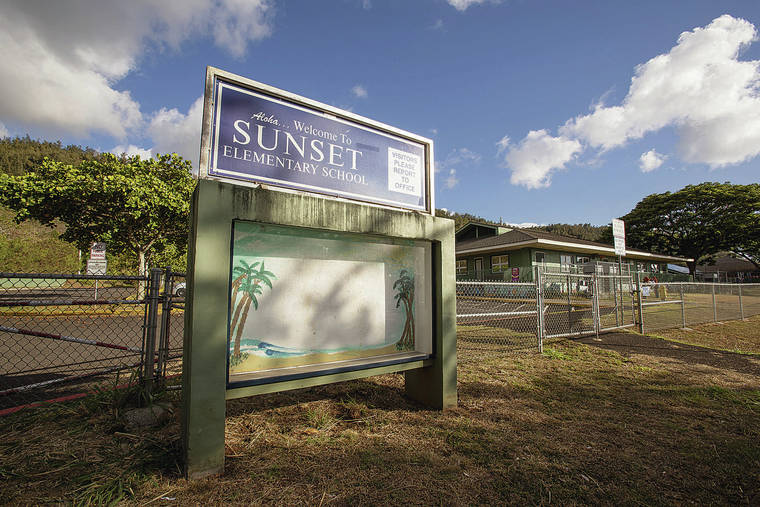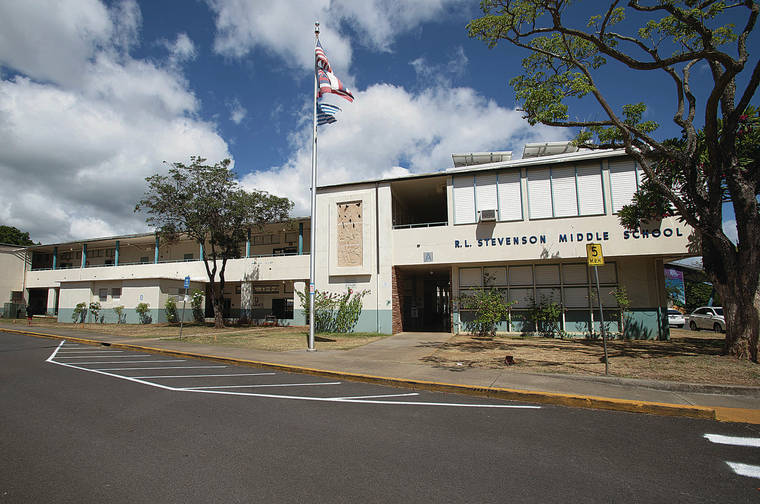Some students could return to Hawaii public schools after fall break


CINDY ELLEN RUSSELL / CRUSSELL@STARADVERTISER.COM
The state Department of Health has provided benchmarks for when schools could go back to in-person learning. Some public schools may offer blended learning later this fall. Sunset Elementary School offered a welcoming sign Thursday.

CINDY ELLEN RUSSELL / CRUSSELL@STARADVERTISER.COM
Flags flapped in the breeze Thursday at Stevenson Middle School.



Some public schools may offer blended learning later this fall under new Health Department benchmarks, but families should expect to start the second quarter Oct. 12 still in distance learning.
The Department of Health on Thursday released long-awaited metrics Opens in a new tab, including ranges of COVID-19 Opens in a new tab case counts, to help determine when schools should open or close. The model has been implemented in other states, the department said, but the benchmarks were promptly blasted as “dangerous” by the Hawaii State Teachers Association.
A key threshold is the number of positive COVID-19 cases per 10,000 population over a 14-day period, by island. Depending on the number of cases, schools may opt for in-person learning at the school or distance learning at home. A third option is “blended” learning, a combination of in-person and virtual classes, with students rotating on campus on different days.

Don't miss out on what's happening!
Stay in touch with breaking news, as it happens, conveniently in your email inbox. It's FREE!
As of Thursday, Kauai, Maui and Lanai would qualify for in-person learning at all levels, with rates of 0.1, 2.0 and 0.0 cases per 10,000. Meanwhile, Oahu could consider blended learning with 19.9 cases per 10,000, according to the metrics. Hawaii island and Molokai, with 10.7 and 12.3 cases respectively, could offer in-person learning to elementary students and blended learning for secondary students.
Dr. Sarah Kemble, acting state epidemiologist, stressed that community case rates are just part of the decision-making. Schools must also be able to mitigate and prevent spread of the new coronavirus, she said.
That includes enforcing physical distancing, masking, keeping students and staff in small groups, providing protective equipment including masks and face shields for all student support personnel, hygiene, regular cleaning and disinfection, among other factors.
“We know that when schools begin in-person learning, there will inevitably be positive cases,” Kemble said. “All schools must be well prepared for this.”
Kemble appeared with Gov. David Ige and schools Superintendent Christina Kishimoto at a briefing Thursday to announce the release of the 28-page guidance Opens in a new tab and Hawaii Metrics for School Reopening Opens in a new tab, which are posted at health.hawaii.gov Opens in a new tab.
“The Department of Health’s new metrics are a welcome tool that will help our schools plan for a safe and strategic, gradual return to our blended learning models,” Kishimoto said. “To minimize disruption, parents should assume that the second quarter will begin as a continuation of learning from home.”
HSTA President Corey Rosenlee said he was shocked by the metrics indicating that a return to blended learning would be appropriate. His members want to ensure full distance learning for all and the option to telework at least through the end of the year for everyone’s safety.
“These metrics are so far outside the norm of what is happening in the rest of this country that it’s going to put not only our teachers and our students, but the entire community at risk,” Rosenlee said. “This is dangerous.”
And he scoffed at the idea that other required measures for a safe return for students and staff would be implemented at public schools.
“We have absolutely no confidence that they are going to follow the checklist, because what we’ve heard across the state with just some students on campus, they are not being followed,” Rosenlee said.
Kishimoto said that any return to campus would be phased according to local conditions, student needs and adequate school preparations. Planning and decision-making will be at the level of the school complex, which are groups of two or three high schools and their feeder lower schools.
“The variation we are seeing in case counts within individual communities means that we cannot adopt a statewide approach for all schools at one time,” she said.
Younger students, who struggle most with distance learning, could be among the earliest to return to in-person instruction, she said.
Hawaii’s public schools are in their fifth week of instruction this first quarter, with the vast majority of 179,000 students learning from home. Teachers and staff are coming to campus, along with about 3,000 students who have special needs, according to Kishimoto.
The superintendent said a full return to in-person instruction would not come until January at the earliest. According to the metrics, only when case counts are below 5 per 10,000 would in-person instruction for all be advised at elementary and secondary schools. Conversely, if the case count exceeds 35, everyone should be learning from home.
From Sept. 1 to Monday, Oahu had 1,937 cases in a population of 974,563, which translates to 19.9 cases per 10,000. The metrics suggest that when the case count is between 15.1 and 25, both elementary and secondary schools should consider blended learning.
Rosenlee warned that other districts have found out the hard way that opening can backfire.
“Every major school district is either closed and doing distance learning, or the ones that have tried to open have had a huge amount of cases and had to close,” he said.
Public school parents were given the option to choose full distance learning for their children either for this semester or for the entire year. Children already in that mode would not be affected by a return to school in the second quarter.
While some families remain wary, others are eager to have their children back on campus, learning from their teachers among their peers and allowing parents to return to their jobs.
“Our ability to restart our economy depends in part on schools opening up safely so parents can go back to work without worrying about the well-being of our children,” Ige said.
20200916 COVID 19 Guidance for Schools UPDATE by Honolulu Star-Advertiser on Scribd



